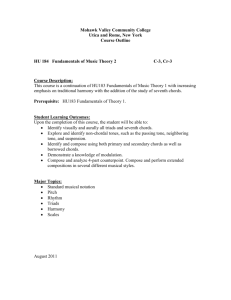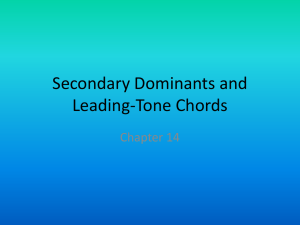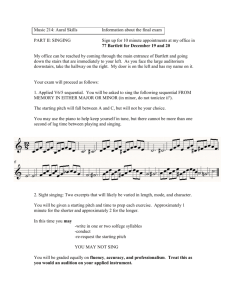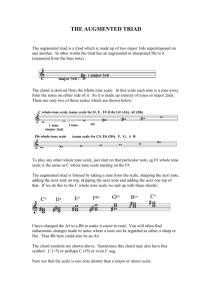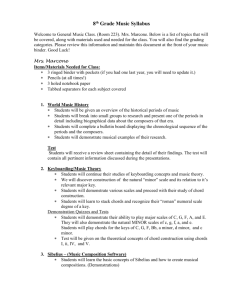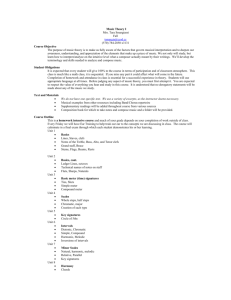secondary dominant - Mary Ellen Haupert
advertisement
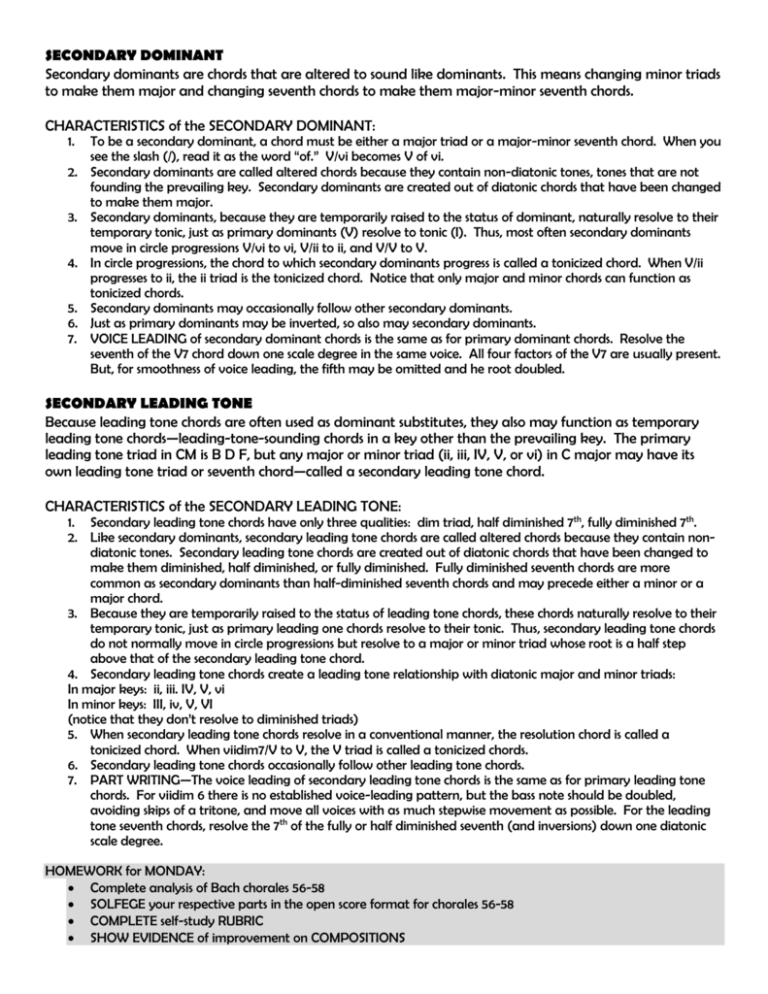
SECONDARY DOMINANT Secondary dominants are chords that are altered to sound like dominants. This means changing minor triads to make them major and changing seventh chords to make them major-minor seventh chords. CHARACTERISTICS of the SECONDARY DOMINANT: 1. 2. 3. 4. 5. 6. 7. To be a secondary dominant, a chord must be either a major triad or a major-minor seventh chord. When you see the slash (/), read it as the word “of.” V/vi becomes V of vi. Secondary dominants are called altered chords because they contain non-diatonic tones, tones that are not founding the prevailing key. Secondary dominants are created out of diatonic chords that have been changed to make them major. Secondary dominants, because they are temporarily raised to the status of dominant, naturally resolve to their temporary tonic, just as primary dominants (V) resolve to tonic (I). Thus, most often secondary dominants move in circle progressions V/vi to vi, V/ii to ii, and V/V to V. In circle progressions, the chord to which secondary dominants progress is called a tonicized chord. When V/ii progresses to ii, the ii triad is the tonicized chord. Notice that only major and minor chords can function as tonicized chords. Secondary dominants may occasionally follow other secondary dominants. Just as primary dominants may be inverted, so also may secondary dominants. VOICE LEADING of secondary dominant chords is the same as for primary dominant chords. Resolve the seventh of the V7 chord down one scale degree in the same voice. All four factors of the V7 are usually present. But, for smoothness of voice leading, the fifth may be omitted and he root doubled. SECONDARY LEADING TONE Because leading tone chords are often used as dominant substitutes, they also may function as temporary leading tone chords—leading-tone-sounding chords in a key other than the prevailing key. The primary leading tone triad in CM is B D F, but any major or minor triad (ii, iii, IV, V, or vi) in C major may have its own leading tone triad or seventh chord—called a secondary leading tone chord. CHARACTERISTICS of the SECONDARY LEADING TONE: 1. Secondary leading tone chords have only three qualities: dim triad, half diminished 7th, fully diminished 7th. 2. Like secondary dominants, secondary leading tone chords are called altered chords because they contain nondiatonic tones. Secondary leading tone chords are created out of diatonic chords that have been changed to make them diminished, half diminished, or fully diminished. Fully diminished seventh chords are more common as secondary dominants than half-diminished seventh chords and may precede either a minor or a major chord. 3. Because they are temporarily raised to the status of leading tone chords, these chords naturally resolve to their temporary tonic, just as primary leading one chords resolve to their tonic. Thus, secondary leading tone chords do not normally move in circle progressions but resolve to a major or minor triad whose root is a half step above that of the secondary leading tone chord. 4. Secondary leading tone chords create a leading tone relationship with diatonic major and minor triads: In major keys: ii, iii. IV, V, vi In minor keys: III, iv, V, VI (notice that they don’t resolve to diminished triads) 5. When secondary leading tone chords resolve in a conventional manner, the resolution chord is called a tonicized chord. When viidim7/V to V, the V triad is called a tonicized chords. 6. Secondary leading tone chords occasionally follow other leading tone chords. 7. PART WRITING—The voice leading of secondary leading tone chords is the same as for primary leading tone chords. For viidim 6 there is no established voice-leading pattern, but the bass note should be doubled, avoiding skips of a tritone, and move all voices with as much stepwise movement as possible. For the leading tone seventh chords, resolve the 7th of the fully or half diminished seventh (and inversions) down one diatonic scale degree. HOMEWORK for MONDAY: Complete analysis of Bach chorales 56-58 SOLFEGE your respective parts in the open score format for chorales 56-58 COMPLETE self-study RUBRIC SHOW EVIDENCE of improvement on COMPOSITIONS
